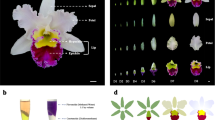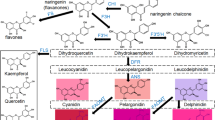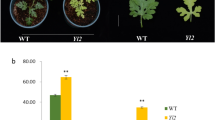Spectacular morning glory blooms rely on a behind-the-scenes proton exchanger.
Abstract
The coloration of blue flowers depends on the production of the appropriate anthocyanin pigments, the presence of metal ions and co-pigments, and the vacuolar pH1. An increase in vacuolar pH enhances blue coloration1,2, but little is known about the proteins responsible for raising the vacuolar pH. Here we show that a mutant purple-flowering Japanese morning glory (Ipomoea nil) plant that carries a recessive mutation in the gene encoding a vacuolar Na+/H+-exchanger is unable to increase its vacuolar pH to create the normal bright blue petals.
Similar content being viewed by others
Main
In the morning glory Ipomoea tricolor, reddish-purple buds unfurl into blue flowers. As the bloom opens, the vacuolar pH in the flower epidermis increases from 6.6 to 7.7 (ref. 2). The colour is very similar to that of I. nil, and the flowers of both plants contain the same anthocyanin as their principal pigment2,3.
Ipomoea nil plants bearing the purple-mutable (pr-m; Fig. 1a) allele in the Purple (Pr) locus have purple flowers with blue sectors4 (Fig. 1a) owing to recurrent somatic mutation from the recessive pr-m to the blue Purple-revertant (Pr-r; Fig. 1b) allele. We have produced germinal revertants (heterogenotes, Pr-r/pr-m ) that have blue flowers (Fig. 1b) and, after self-pollination, we chose pairs of siblings carrying either the pr-m or Pr-r allele homozygously. We found no difference in the pigment composition of the pr-m and Pr-r lines, but the pH of the sap from the Pr-r flower epidermis was higher than that in pr-m by about 0.7, indicating that the pr mutant fails to increase the vacuolar pH.
As Tpn1-related transposons are a common spontaneous mutagen in I. nil5, we used a transposon-display procedure6 to identify the Pr gene. Sequencing of Pr complementary DNA (accession no. AB033989) revealed that it contains an open reading frame that is highly homologous to the Arabidopsis and rice vacuolar Na+/H+-exchangers7,8 and that it complements the yeast nhx1 mutation7 (our unpublished results), confirming that the Pr gene encodes a vacuolar Na+/H+-exchanger. We named this transporter InNhx1 (for I. nil Nhx1).
The Pr gene itself (accession no. AB033990) comprises 15 exons and a Tpn1-related element, Tpn4, which is integrated into its first exon in the pr-m lines (Fig. 1c). This integration of Tpn4 generates a 3-base-pair target duplication, and the germinal revertants studied here contain footprints generated by Tpn4 excision (Fig. 1d). Moreover, blue sectors of the variegated flowers contain footprints that result from somatic excision of Tpn4, whereas we found no evidence of such excision in the purple regions of these flowers in six different pr-m lines. To our knowledge, the Pr gene encoding InNhx1 is the first gene to be identified that increases the vacuolar pH in petals in order to confer blue coloration.
References
Mol, J., Grotewold, E. & Koes, R. Trends Plant Sci. 3, 212– 217 (1998).
Yoshida, K., Kondo, T., Okazaki, Y. & Katou, K. Nature 373, 291 (1995).
Lu, T. S., Saito, N., Yokoi, M., Shigihara, A. & Honda, T. Phytochemistry 31, 659– 663 (1992).
Imai, Y. J. Coll. Agric. Imp. Univ. Tokyo 12, 479– 523 (1934).
Iida, S., Hoshino, A., Johzuka-Hisatomi, Y., Habu, Y . & Inagaki, Y. Ann. NY Acad. Sci. 870 , 265–274 (1999).
Maes, T., De Keukeleire, P. & Gerats, T. Trends Plant Sci. 4, 90– 96 (1999).
Gaxiola, R. A. et al. Proc. Natl Acad. Sci. USA 96, 1480– 1485 (1999).
Fukuda, A., Nakamura, A. & Tanaka, Y. Biochim. Biophys. Acta 1446, 149–155 (1999).
Author information
Authors and Affiliations
Corresponding author
Rights and permissions
About this article
Cite this article
Fukada-Tanaka, S., Inagaki, Y., Yamaguchi, T. et al. Colour-enhancing protein in blue petals. Nature 407, 581 (2000). https://doi.org/10.1038/35036683
Issue Date:
DOI: https://doi.org/10.1038/35036683
This article is cited by
-
A DNA nanodevice for mapping sodium at single-organelle resolution
Nature Biotechnology (2023)
-
Flower color modification through co-overexpression of the VtF3′5′H and RhNHX genes in Rosa hybrida
Plant Cell, Tissue and Organ Culture (PCTOC) (2023)
-
Mechanisms and regulation of organic acid accumulation in plant vacuoles
Horticulture Research (2021)
-
Gain-of-function mutations of AtNHX1 suppress sos1 salt sensitivity and improve salt tolerance in Arabidopsis
Stress Biology (2021)
-
Intelligent Surfaces Thermally Switchable between the Highly Rough and Entirely Smooth States
Chinese Journal of Polymer Science (2021)
Comments
By submitting a comment you agree to abide by our Terms and Community Guidelines. If you find something abusive or that does not comply with our terms or guidelines please flag it as inappropriate.




